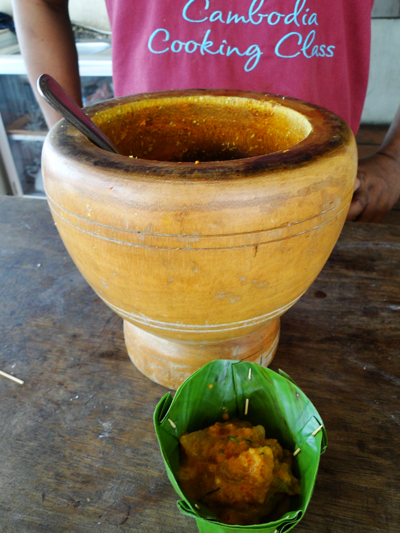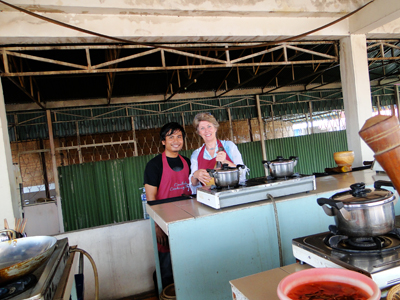Running Amok in Cambodian Cooking Classes
Hung Ly Hen, or “Lucky” as he’s better known, is showing me how to fold a banana leaf into a pretty cup shape. The idea is to make a container to hold the famous Cambodian dish, Amok.
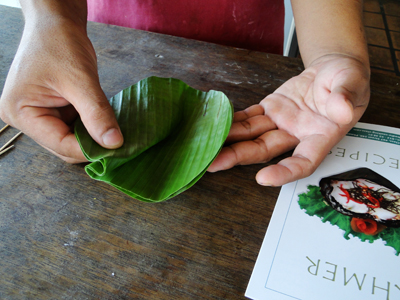 First he traces a 25cm circle shape onto the leaf, then cuts it out, and is now holding it over a naked flame to soften it.
“You can also dip it into hot water,” he says. “But this is the quickest way. You don’t want to burn it, just let it get soft.”
He now hands me 2 of the circles and some toothpicks which he breaks into halves. He places both of the circles together and makes a square in the middle to form the bottom of the cup. Then he makes a tuck and secures it with a halved toothpick, then hands the leaves to me to finish with four more pleats. He’s so quick and deft, and at first I feel rather clumsy. Finally I get the hang of it, and manage to make a quite a nifty container.
Into this I’ll spoon the Amok, a fragrant spicy mixture of cubed fish, krahorm kroeung (red curry paste) and coconut milk (see recipe). Fish is the most traditional ingredient used in Amok but you can also use chicken.
“Would you like to taste the frog amok next time?” asks Lucky.
Lucky is the bright, cheeky, English-speaking chef at the Cambodian Cooking School in Phnom Penh where he teaches a variety of traditional khmer dishes such as samlor kor ko (vegetarian soup), saing jayk (banana blossom sausages), lok lak (sizzling beef in Khmer sauce) and jek ktih (coconut banana and tapioca).
His story is typical of many 20-something Cambodians. A street child until the age of ten, he was taken in by Friends, a non-government organisation which plucks children off the streets, shelters and houses them and teaches them vocational skills such as cooking, hospitality, sewing and mechanics. Lucky learnt to cook at the Friends’ restaurant, Ramdeng, a colourful, vibrant oasis in the middle of Pnomh Penh.
Before being shown how to make the amok, Lucky had taken a group of us to the Kandal markets (the central wet markets) where he showed us a wide variety of fresh vegetables and fruits, some of which we rarely see for sale in our markets: morning glory, jungle greens, smelly durian, red snake-skin salaks, insects (cockroaches, tarantulas, water beetles, locusts) and prahok, the potent Cambodian fish paste which smells like strong blue cheese.
First he traces a 25cm circle shape onto the leaf, then cuts it out, and is now holding it over a naked flame to soften it.
“You can also dip it into hot water,” he says. “But this is the quickest way. You don’t want to burn it, just let it get soft.”
He now hands me 2 of the circles and some toothpicks which he breaks into halves. He places both of the circles together and makes a square in the middle to form the bottom of the cup. Then he makes a tuck and secures it with a halved toothpick, then hands the leaves to me to finish with four more pleats. He’s so quick and deft, and at first I feel rather clumsy. Finally I get the hang of it, and manage to make a quite a nifty container.
Into this I’ll spoon the Amok, a fragrant spicy mixture of cubed fish, krahorm kroeung (red curry paste) and coconut milk (see recipe). Fish is the most traditional ingredient used in Amok but you can also use chicken.
“Would you like to taste the frog amok next time?” asks Lucky.
Lucky is the bright, cheeky, English-speaking chef at the Cambodian Cooking School in Phnom Penh where he teaches a variety of traditional khmer dishes such as samlor kor ko (vegetarian soup), saing jayk (banana blossom sausages), lok lak (sizzling beef in Khmer sauce) and jek ktih (coconut banana and tapioca).
His story is typical of many 20-something Cambodians. A street child until the age of ten, he was taken in by Friends, a non-government organisation which plucks children off the streets, shelters and houses them and teaches them vocational skills such as cooking, hospitality, sewing and mechanics. Lucky learnt to cook at the Friends’ restaurant, Ramdeng, a colourful, vibrant oasis in the middle of Pnomh Penh.
Before being shown how to make the amok, Lucky had taken a group of us to the Kandal markets (the central wet markets) where he showed us a wide variety of fresh vegetables and fruits, some of which we rarely see for sale in our markets: morning glory, jungle greens, smelly durian, red snake-skin salaks, insects (cockroaches, tarantulas, water beetles, locusts) and prahok, the potent Cambodian fish paste which smells like strong blue cheese.
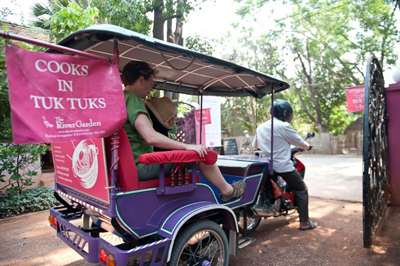 Whilst in Siem Reap, a 6 hour drive north of the capital, I’d also visited local markets with Deborah Saunders, an Australian woman from Melbourne, who runs Cooks in Tuk Tuks. Deborah and her husband own The River Garden where you can stay, surrounded by a luxuriant garden, visit the Angkor Wat temples 20 minutes away by tuk tuk and take a cooking class in an outdoor pavilion.
“We’d had 30 years of holidays in Bali and recognised Cambodia had similar qualities to the Bali of the 1970s,” she says.
Whilst in Siem Reap, a 6 hour drive north of the capital, I’d also visited local markets with Deborah Saunders, an Australian woman from Melbourne, who runs Cooks in Tuk Tuks. Deborah and her husband own The River Garden where you can stay, surrounded by a luxuriant garden, visit the Angkor Wat temples 20 minutes away by tuk tuk and take a cooking class in an outdoor pavilion.
“We’d had 30 years of holidays in Bali and recognised Cambodia had similar qualities to the Bali of the 1970s,” she says.
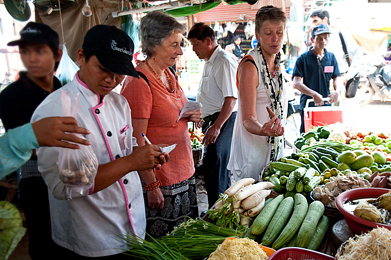 “The qualities of the people here are as endearing, if not moreso, than the Balinese. Their recent history means they are quite needy – 75% of the population is under 25 years of age and there are few elderly people. They are craving for knowledge and want to learn.
“This also means that there’s very little knowledge of their cuisine, so what’s presented to you as a Westerner is a modified version of the original cuisine. There are very few Khmers who have that knowledge and it’s not taught in the culinary institution because they don’t see their cuisine as being suitable to serve in a restaurant situation.”
With regard to the insects which Cambodians eat, Deborah says that her observation is that this habit developed out of starvation.
“The qualities of the people here are as endearing, if not moreso, than the Balinese. Their recent history means they are quite needy – 75% of the population is under 25 years of age and there are few elderly people. They are craving for knowledge and want to learn.
“This also means that there’s very little knowledge of their cuisine, so what’s presented to you as a Westerner is a modified version of the original cuisine. There are very few Khmers who have that knowledge and it’s not taught in the culinary institution because they don’t see their cuisine as being suitable to serve in a restaurant situation.”
With regard to the insects which Cambodians eat, Deborah says that her observation is that this habit developed out of starvation.
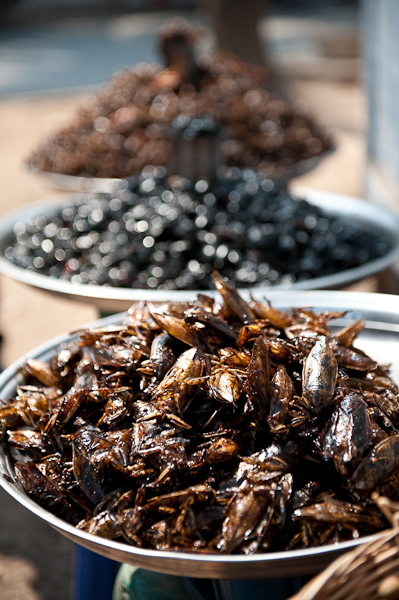 “The crunch and texture is no different from eating BBQ prawns with their skin on or the tip of a chicken wing.”
Her classes depart daily at 10am from The River Garden – a tuk tuk takes you into the central market, then back for the class in the pavilion. Such classes are a terrific way to find out more about Cambodian life and culture.
“The crunch and texture is no different from eating BBQ prawns with their skin on or the tip of a chicken wing.”
Her classes depart daily at 10am from The River Garden – a tuk tuk takes you into the central market, then back for the class in the pavilion. Such classes are a terrific way to find out more about Cambodian life and culture.
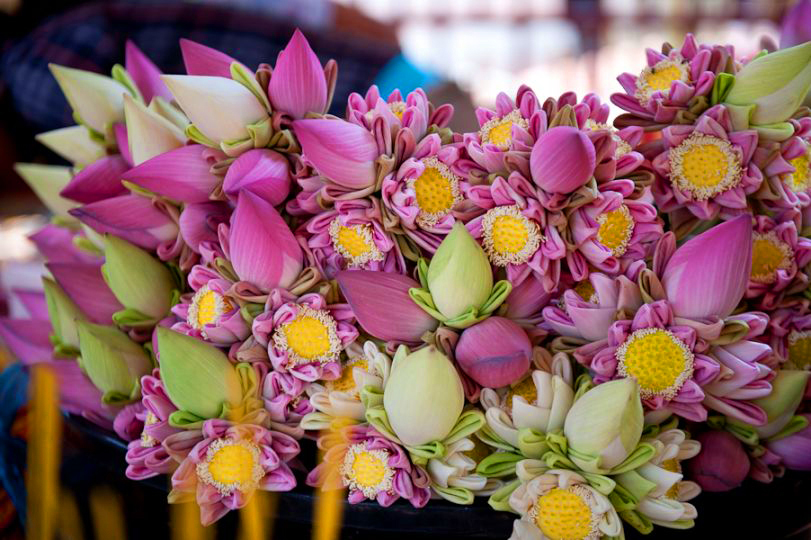 In Cambodia, I was a guest of Travel Indochina, a Sydney-based company which organises bespoke tailor-made programs for individuals or small groups in south-east Asia.
More info: www.travelindochina.com.au
Phnom Penh Cambodian Cooking Class: www.cambodia-cooking-class.com
Siem Reap Cooks in Tuk Tuks: www.therivergarden.info
In Cambodia, I was a guest of Travel Indochina, a Sydney-based company which organises bespoke tailor-made programs for individuals or small groups in south-east Asia.
More info: www.travelindochina.com.au
Phnom Penh Cambodian Cooking Class: www.cambodia-cooking-class.com
Siem Reap Cooks in Tuk Tuks: www.therivergarden.info

Folding banana leaf for amok

Cooks in Tuk Tuks, Siem Reap

Deborah Saunders (far right) at the Siem Reap market

Cockroaches for sale at Siem Reap Market

Lotus blossoms at Siem Reap Market Cambodia

